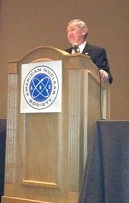 Tom D. Kilgore, president and chief executive officer of the Tennesee Valley Authority, was one of two keynote speakers at the opening plenary of the conference. The other speaker was Marine Corporal Josh Bleill, a double-amputee Purple Heart veteran and a spokesperson for the Indianapolis Colts NFL football team.
Tom D. Kilgore, president and chief executive officer of the Tennesee Valley Authority, was one of two keynote speakers at the opening plenary of the conference. The other speaker was Marine Corporal Josh Bleill, a double-amputee Purple Heart veteran and a spokesperson for the Indianapolis Colts NFL football team.
 Mr. Kilgore emphasized the value of consistent performance. "As nuclear operators expand their capabilities, we must all be committed to safety, reliability, quality, and people to drive consistent performance. When it comes to nuclear operations at TVA, we are listening, we are learning, and we are improving," Kilgore said.
Mr. Kilgore emphasized the value of consistent performance. "As nuclear operators expand their capabilities, we must all be committed to safety, reliability, quality, and people to drive consistent performance. When it comes to nuclear operations at TVA, we are listening, we are learning, and we are improving," Kilgore said.
Mr. Kilgore stressed the importance of collaborative effort across the nuclear industry. "Regulatory decisions and the public's perception of nuclear energy have less to do with how we operate individually than with how our industry performs as a whole. That's why the future success of nuclear requires a collaborative effort by the nuclear energy industry, researchers and educators to build state-of-the-art equipment, push the envelope on new technologies and develop the next generation of safety."
Kilgore shared ways that TVA is being more transparent and encouraging more dialog with stakeholders, pointing out the need for clear communication. "We need to help people see that nuclear energy isn't just a logical choice for meeting our future energy needs," Kilgore said. "It's also a logical choice for economic investment and quality jobs for communities that host nuclear facilities."
Among the comments in Kilgore's keynote address, tweeted at the TVA twitter feed, were examples regarding economic benefits in the Tennessee Valley region:
- One nuclear facility can generate more 700 permanent jobs.
- One nuclear facility can drive $470 million in goods and services every year.
- One nuclear facility can yield $83 million in federal, state, and local taxes every year.
In sum, Kilgore said, "Nuclear is the right way forward for our nation."
TVA's Integrated Resource Plan includes a balanced and diverse portfolio of energy sources for the region, with a goal of 30 percent contribution each from nuclear, coal, and gas, with hydro providing the remaining 10 percent.
____________________








